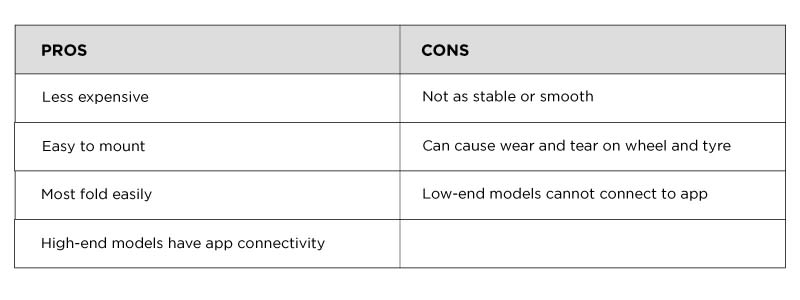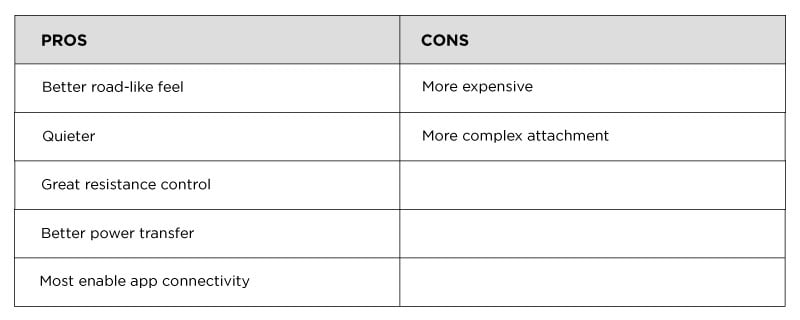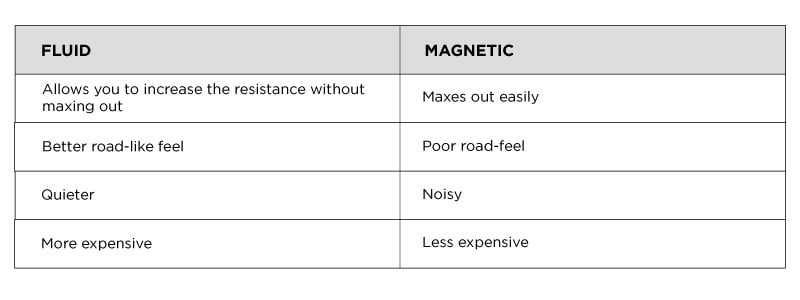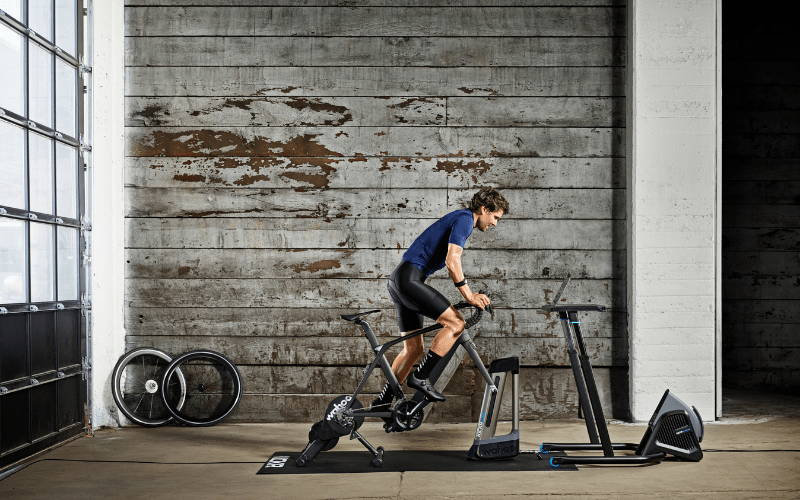

Nothing beats a good cycle on a glorious day; racing through the wind with the sun on your face. Unfortunately, it’s not always possible to get outside - which is when many cyclists rely on an indoor trainer for a solid workout.
Not only do they allow for a convenient and time-efficient training session - they enable serious athletes to perform targeted workouts - improving cardiovascular fitness, stamina and speed. Bonus? You can do all of that without being dependent on the weather or getting your bike dirty.
Sounds like your new best friend, right?
Let’s delve a little deeper into the world of indoor trainers so that you can make an educated decision and purchase the best one for your needs right now.
Types of Indoor Trainers
Wheel-on trainers: These indoor trainers attach to your bicycle’s rear wheel and offer resistance by means of a roller that presses against the tyre.

Direct-Drive trainers: These indoor trainers require you to remove the rear wheel of your bicycle and attach directly to your bicycle’s drivetrain. Direct-drive trainers are great because they eliminate the change in tyre pressure on overall power transfer and you won’t have to worry about using a trainer tyre while riding.

Types of Resistance
1. Fluid: With fluid indoor trainers, a “roller” on the trainer connects to an impeller that rotates through fluid which provides the resistance.
2. Magnetic: These indoor trainers make use of a magneto that can be manually adjusted for the desired resistance.

Note: Most smart trainers are made with magnetic resistance but their technology is extremely sophisticated compared to basic magnetic indoor trainers.
Conclusion: If you are going the traditional route - opt for a fluid indoor trainer. This is found on most wheel-on trainers, valued for its smooth and quiet operation. However, the sophisticated electronically-controlled flywheels in many smart direct-drive trainers also operate smoothly and quietly. These are notably more expensive.
Should you purchase a smart indoor trainer?

Smart indoor trainers offer you the ability to connect wirelessly to training apps and software-controlled sensors to change the resistance to match the topography of virtual workouts. Cycle a little harder, your application will know it; when the course ventures uphill, the trainer will know it. These smart trainers are usually driven by direct connection to your bicycle chain.
Should you get one?
Well, a good starting point would be to consider your budget.
If you’re a keen cycling enthusiast that really loves interacting with your online community, or an elite athlete who trains hard and fiercely needs to keep track of their training efficiency - you would really get the most out of this smart technology. The smart trainer provides excellent feedback on your training metrics for improved efficiency over time - plus gamification features make for really fun (and borderline addictive) workouts.
But if you’re a beginner cyclist on a budget, you may want to think twice before forking out the big bucks for this elite training apparatus. They don’t come cheap. Smart indoor trainers are also much more complicated to set up. It’s not just a matter of attaching your bike and off you go. Most smart trainers require you to completely remove the wheel (and sometimes the cartridge), putting the cartridge on the smart trainer, plugging everything in, then still needing to sync to whichever training app you will be using. If you’re looking for something simple and easy to set up for training on a random rainy day, a traditional trainer may be more your speed.
Conclusion: Smart indoor trainers are more complicated to set up and are more expensive but offer impressive training metrics, interaction with an online active community, interactive classes and fun gamification features that make working out a pleasure.
Factors to keep in mind when buying an indoor trainer:
1. Budget: The price you are willing to pay is probably the best starting point when purchasing an indoor trainer. As a beginner cyclist you might consider buying a less costly indoor trainer - and who knows, you might evolve into an avid cyclist who lives for intense daily training whatever the weather - in which case a smart indoor trainer will be worth the investment. Most often, the biggest difference between the more expensive trainers is the level of immersive technology.
2. Tech: Indoor trainers are becoming more and more sophisticated with some impressive tech to go along with it. Now you can buy trainers with built-in power meters that can integrate with streamed workouts from a variety of platforms. Advanced tech can more than double the price, but for the right person it will be more than worth it.
3. Compatibility: Most bicycles are compatible with most indoor trainers, but you may need to double check if you own a fancier bicycle - especially changes toward the rear-most part of the frame and rear dropout area. It is also important to check your manufacturer’s warranty, as some may void the warranty if you break the carbon fiber frame while using a trainer.
4. Noise: Some indoor trainers are noisier than others. If you’re someone bothered by noise - make sure to purchase a quieter variety (some even come with decibel readings). Wheel-on trainers are noisier than direct-drive trainers and fluid resistance trainers are quieter than magnetic resistance trainers. However, many smart trainers work through magnetic resistance mechanisms and have been specially designed to be quieter.
5. Potential resistance: This is the amount of power output your trainer can handle before it maxes out. If you’re a beginner cyclist, or only require an indoor trainer for the odd rainy day then an entry-level indoor trainer can be all you need. If you take your training very seriously, opt for the advanced bike trainer.
6. Durability: As above - if you’re really serious about your training and regularly perform intense workouts and long distances - don’t skimp on an indoor trainer. You need something durable that will withstand long rides and save you money in the long run.
7. Functionality: Think about how and how often you will be using your indoor trainer. Will you only be using it every now and then when the weather forces you to bring your training indoors? In that case, you may be interested in a trainer that is easy to set up quickly - which means it needs to be stored easily, shouldn’t be too heavy, and should be quick and easy to get your bike set up. If you enjoy regular training and perhaps have a designated training area, you may be more flexible in those aspects but prefer a sturdier, more stable trainer.
Final Thoughts
Buying an indoor trainer doesn’t need to be complicated, but it’s always important to think about what works best for you, your budget, and your training style.
Are you a newbie cyclist with a limited budget? Or someone who only intends to use an indoor trainer on the odd occasion? Then you may want to look at entry-level models first to get a feel for training indoors. Are you an avid cyclist who enjoys regular, intense training sessions with a passion for tech? Go for the smart indoor trainer - the investment will be worth it!

